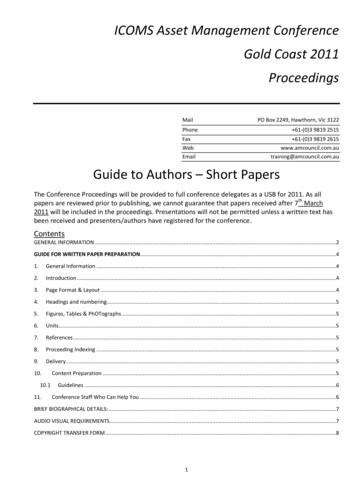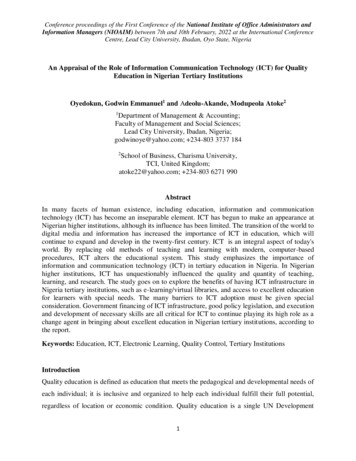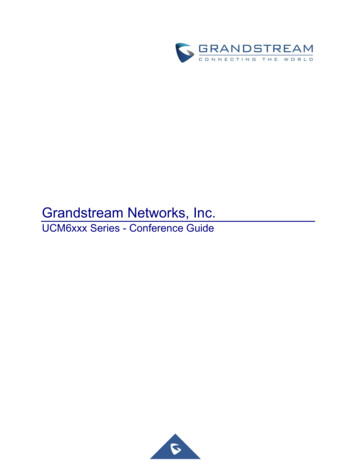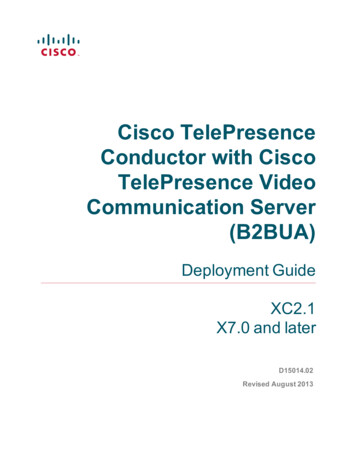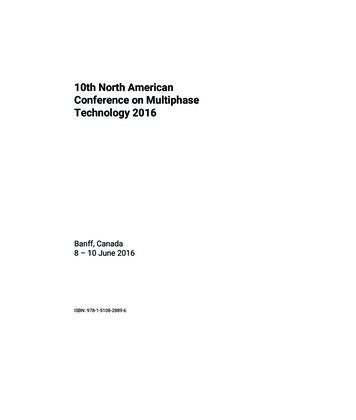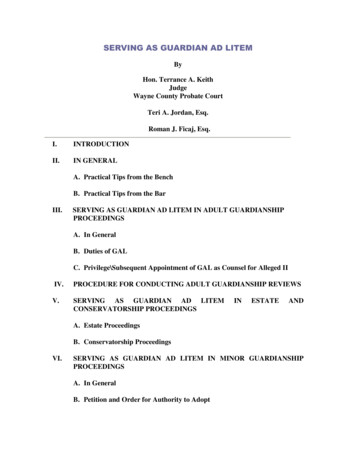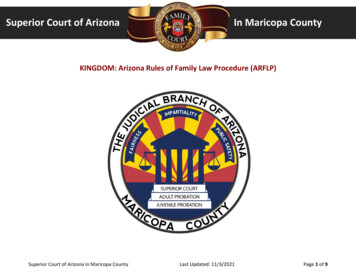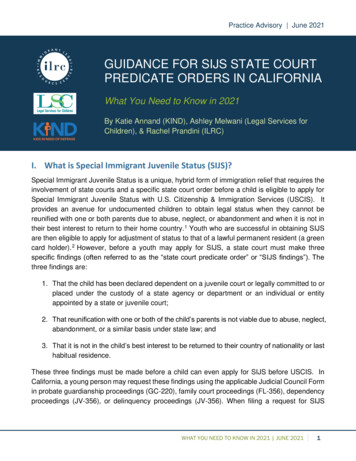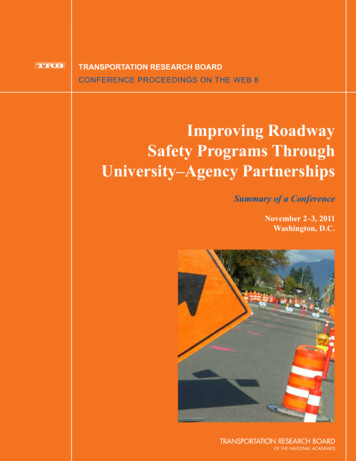
Transcription
TRANSPORTATION RESEARCH BOARDCONFERENCE PROCEEDINGS ON THE WEB 8Improving RoadwaySafety Programs ThroughUniversity–Agency PartnershipsSummary of a ConferenceNovember 2–3, 2011Washington, D.C.
TRANSPORTATION RESEARCH BOARD2012 EXECUTIVE COMMITTEE*Chair: Sandra Rosenbloom, Director, Innovation in Infrastructure, The Urban Institute, Washington, D.C.Vice Chair: Deborah H. Butler, Executive Vice President, Planning, and CIO, Norfolk Southern Corporation, Norfolk, VirginiaExecutive Director: Robert E. Skinner, Jr., Transportation Research BoardVictoria A. Arroyo, Executive Director, Georgetown Climate Center, and Visiting Professor, Georgetown University Law Center,Washington, D.C.J. Barry Barker, Executive Director, Transit Authority of River City, Louisville, KentuckyWilliam A. V. Clark, Professor of Geography (emeritus) and Professor of Statistics (emeritus), Department of Geography, University ofCalifornia, Los AngelesEugene A. Conti, Jr., Secretary of Transportation, North Carolina Department of Transportation, RaleighJames M. Crites, Executive Vice President of Operations, Dallas–Fort Worth International Airport, TexasPaula J. C. Hammond, Secretary, Washington State Department of Transportation, OlympiaMichael W. Hancock, Secretary, Kentucky Transportation Cabinet, FrankfortChris T. Hendrickson, Duquesne Light Professor of Engineering, Carnegie Mellon University, Pittsburgh, PennsylvaniaAdib K. Kanafani, Professor of the Graduate School, University of California, Berkeley (Past Chair, 2009)Gary P. LaGrange, President and CEO, Port of New Orleans, LouisianaMichael P. Lewis, Director, Rhode Island Department of Transportation, ProvidenceSusan Martinovich, Director, Nevada Department of Transportation, Carson CityJoan McDonald, Commissioner, New York State Department of Transportation, AlbanyMichael R. Morris, Director of Transportation, North Central Texas Council of Governments, Arlington (Past Chair, 2010)Tracy L. Rosser, Vice President, Regional General Manager, Wal-Mart Stores, Inc., Mandeville, LouisianaHenry G. (Gerry) Schwartz, Jr., Chairman (retired), Jacobs/Sverdrup Civil, Inc., St. Louis, MissouriBeverly A. Scott, General Manager and CEO, Metropolitan Atlanta Rapid Transit Authority, Atlanta, GeorgiaDavid Seltzer, Principal, Mercator Advisors LLC, Philadelphia, PennsylvaniaKumares C. Sinha, Olson Distinguished Professor of Civil Engineering, Purdue University, West Lafayette, IndianaThomas K. Sorel, Commissioner, Minnesota Department of Transportation, St. PaulDaniel Sperling, Professor of Civil Engineering and Environmental Science and Policy; Director, Institute of Transportation Studies; andActing Director, Energy Efficiency Center, University of California, DavisKirk T. Steudle, Director, Michigan Department of Transportation, LansingDouglas W. Stotlar, President and Chief Executive Officer, Con-Way, Inc., Ann Arbor, MichiganC. Michael Walton, Ernest H. Cockrell Centennial Chair in Engineering, University of Texas, Austin (Past Chair, 1991)Rebecca M. Brewster, President and COO, American Transportation Research Institute, Smyrna, Georgia (ex officio)Anne S. Ferro, Administrator, Federal Motor Carrier Safety Administration, U.S. Department of Transportation (ex officio)LeRoy Gishi, Chief, Division of Transportation, Bureau of Indian Affairs, U.S. Department of the Interior, Washington, D.C. (ex officio)John T. Gray II, Senior Vice President, Policy and Economics, Association of American Railroads, Washington, D.C. (ex officio)John C. Horsley, Executive Director, American Association of State Highway and Transportation Officials, Washington, D.C.(ex officio)Michael P. Huerta, Acting Administrator, Federal Aviation Administration, U.S. Department of Transportation (ex officio)David T. Matsuda, Administrator, Maritime Administration, U.S. Department of Transportation (ex officio)Michael P. Melaniphy, President and CEO, American Public Transportation Association, Washington, D.C. (ex officio)Victor M. Mendez, Administrator, Federal Highway Administration, U.S. Department of Transportation (ex officio)Tara O’Toole, Under Secretary for Science and Technology, U.S. Department of Homeland Security (ex officio)Robert J. Papp (Adm., U.S. Coast Guard), Commandant, U.S. Coast Guard, U.S. Department of Homeland Security (ex officio)Cynthia L. Quarterman, Administrator, Pipeline and Hazardous Materials Safety Administration, U.S. Department of Transportation(ex officio)Peter M. Rogoff, Administrator, Federal Transit Administration, U.S. Department of Transportation (ex officio)David L. Strickland, Administrator, National Highway Traffic Safety Administration, U.S. Department of Transportation (ex officio)Joseph C. Szabo, Administrator, Federal Railroad Administration, U.S. Department of Transportation (ex officio)Polly Trottenberg, Assistant Secretary for Transportation Policy, U.S. Department of Transportation (ex officio)Robert L. Van Antwerp (Lt. General, U.S. Army), Chief of Engineers and Commanding General, U.S. Army Corps of Engineers,Washington, D.C. (ex officio)Barry R. Wallerstein, Executive Officer, South Coast Air Quality Management District, Diamond Bar, California (ex officio)Gregory D. Winfree, Acting Administrator, Research and Innovative Technology Administration, U.S. Department of Transportation(ex officio)* Membership as of November 2012.
CONFERENCE PROCEEDINGS ON THE WEB 8Improving Roadway Safety ProgramsThrough University–Agency PartnershipsSummary of a ConferenceKatherine F. Turnbull, RapporteurNovember 2–3, 2011Keck Center of the National AcademiesWashington, D.C.Sponsored byUniversity Transportation Centers Program,Research and Innovative Technology Administration, U.S. Department of TransportationTransportation Research BoardWashington, D.C.2012www.TRB.org
Transportation Research Board Conference Proceedings on the Web 8Transportation Research Board publications are available by ordering individual publications directly fromthe TRB Business Office, through the Internet at www.TRB.org or national-academies.org/trb, or by annualsubscription through organizational or individual affiliation with TRB. Affiliates and library subscribers areeligible for substantial discounts. For further information, contact the Transportation Research Board BusinessOffice, 500 Fifth Street, NW, Washington, DC 20001 (telephone 202-334-3213; fax 202-334-2519; or e-mailTRBsales@nas.edu).NOTICE: The project that is the subject of this report was approved by the Governing Board of the NationalResearch Council, whose members are drawn from the councils of the National Academy of Sciences, theNational Academy of Engineering, and the Institute of Medicine. The members of the committee responsiblefor the project were chosen for their special competencies and with regard for appropriate balance.This report has been reviewed by a group other than the authors according to the procedures approved by aReport Review Committee consisting of members of the National Academy of Sciences, the National Academyof Engineering, and the Institute of Medicine.This project was sponsored by the University Transportation Centers Program, Research and InnovativeTechnology Administration, U.S. Department of Transportation, and the Transportation Research Board.Committee for a Conference on Improving Performance-Based, Data-Driven Safety Programs ThroughUniversity–Agency PartnershipsDaniel S. Turner, University of Alabama, Tuscaloosa, ChairBernard J. Arseneau, Minnesota Department of TransportationBenjamin H. Cottrell, Virginia Department of TransportationLeanna Depue, Missouri Department of TransportationKaren K. Dixon, Oregon State UniversityBarbara Harsha, Governors Highway Safety AssociationJake Kononov, Colorado Department of TransportationDenise Osborn, Attorney, Public Health ConsultantReginald R. Souleyrette, University of KentuckyNicholas Ward, Western Transportation InstituteLiaisonsThomas G. Bolle, Research and Innovative Technology AdministrationTamiko Brim-Burnell, Federal Highway AdministrationRobert C. Johns, Research and Innovative Technology AdministrationRobin Kline, Research and Innovative Technology AdministrationCurtis J. Tompkins, Research and Innovative Technology AdministrationTransportation Research Board StaffThomas M. Palmerlee, Associate Division Director, Data and Information ServicesNanda Srinivasan, Senior Program Officer, Cooperative Research ProgramsMatthew A. Miller, Senior Program AssociateJaclyn Hubersberger, Senior Program AssociateTRB Publications OfficeNorman Solomon, EditorJavy Awan, Production EditorJennifer J. Weeks, Editorial Services SpecialistKristin C. Sawyer, ProofreaderPaul deBruijn, Typesetting and Layout
The National Academy of Sciences is a private, nonprofit, self-perpetuating society of distinguishedscholars engaged in scientific and engineering research, dedicated to the furtherance of science andtechnology and to their use for the general welfare. On the authority of the charter granted to it bythe Congress in 1863, the Academy has a mandate that requires it to advise the federal governmenton scientific and technical matters. Dr. Ralph J. Cicerone is president of the National Academy ofSciences.The National Academy of Engineering was established in 1964, under the charter of the NationalAcademy of Sciences, as a parallel organization of outstanding engineers. It is autonomous in itsadministration and in the selection of its members, sharing with the National Academy of Sciencesthe responsibility for advising the federal government. The National Academy of Engineering alsosponsors engineering programs aimed at meeting national needs, encourages education and research,and recognizes the superior achievements of engineers. Dr. Charles M. Vest is president of theNational Academy of Engineering.The Institute of Medicine was established in 1970 by the National Academy of Sciences to securethe services of eminent members of appropriate professions in the examination of policy matterspertaining to the health of the public. The Institute acts under the responsibility given to the NationalAcademy of Sciences by its congressional charter to be an adviser to the federal government and, onits own initiative, to identify issues of medical care, research, and education. Dr. Harvey V. Finebergis president of the Institute of Medicine.The National Research Council was organized by the National Academy of Sciences in 1916 toassociate the broad community of science and technology with the Academy’s purposes of furtheringknowledge and advising the federal government. Functioning in accordance with general policiesdetermined by the Academy, the Council has become the principal operating agency of both theNational Academy of Sciences and the National Academy of Engineering in providing services to thegovernment, the public, and the scientific and engineering communities. The Council is administeredjointly by both Academies and the Institute of Medicine. Dr. Ralph J. Cicerone and Dr. Charles M.Vest are chair and vice chair, respectively, of the National Research Council.The Transportation Research Board is one of six major divisions of the National ResearchCouncil. The mission of the Transportation Research Board is to provide leadership in transportationinnovation and progress through research and information exchange, conducted within a setting thatis objective, interdisciplinary, and multimodal. The Board’s varied activities annually engage about7,000 engineers, scientists, and other transportation researchers and practitioners from the publicand private sectors and academia, all of whom contribute their expertise in the public interest. Theprogram is supported by state transportation departments, federal agencies including the componentadministrations of the U.S. Department of Transportation, and other organizations and individualsinterested in the development of transportation. www.TRB.orgwww.national-academies.org
ContentsPreface.1Opening SessionREALIZING SAFETY IMPROVEMENTS FROMUNIVERSITY–AGENCY PARTNERSHIPS.4Welcome.4.Daniel S. TurnerU.S. DOT: Importance of Safety.5Gregory D. WinfreeU.S. DOT: Importance of Safety.6John PorcariMinnesota DOT: Importance of Safety.7Bernard J. ArseneauUniversity Perspective on Improving University andAgency Partnerships for Transportation Safety.13Stephen AlbertGeneral SessionCOLLABORATIVE EFFORTS TO ENHANCE THE VALUE OFNEW TOOLS AND TECHNIQUES.17Skills Needed for Highway Safety Manual, Safety Analysis,and Potential Safety Improvements.17John MiltonFHWA Safety Research and Developmentand University Partnership Opportunities .20Monique R. EvansSuccessful Examples and Techniques for Collaboration withNontraditional Partners Such as Public Health Agencies.23Denise Osborn
Summary of Key Points on What Makes a SuccessfulAgency–UTC Partnership.25Jake KononovGeneral SessionACTIONS TO IMPROVE COLLABORATIVE CAPABILITIESIN AGENCIES AND UNIVERSITIES.29Summary of Key Points from Project Collaborationand Synergy Breakouts.29Chris MonsereRoad Safety Workforce Development.31Paul JovanisMissouri DOT: Efforts to Improve CollaborationCapacity in Roadway Safety Programs withAgency–University Partnerships.35William StoneUniversity of Minnesota’s Efforts to ImproveUniversity–Agency Collaboration inUTC Roadway Safety Program.37Max DonathGeneral SessionPRIORITIES FOR MOVING FORWARD.44Summary of Key Points on Research Directions Breakout.44Shauna HallmarkActions for Universities to Improve Collaboration.47Karen K. DixonActions for Transportation Agencies to Improve Collaboration.49Bernard J. ArseneauFederal Perspective on Next Steps for ImprovingRoadway Safety Programs in a University–AgencyPartnership Framework.51Robert C. Johnsvi
SUMMARY OF BREAKOUT SESSIONS .55Katherine F. TurnbullKeys to a Successful Partnership and UTC Partnerships .55Methods for Enhancing Project Collaboration and Synergy.57Moving Forward and Research Directions.58Appendix APOSTER SUMMARIES.61Traffic Assistance Services for Kansas: ProvidingQuality Training in Highway Safety Since 1980.61Robert Stokes, Lynn Berges, and Thomas MulinazziCase Study of a University–Transportation AgencyPartnership: Assessing Traffic Safety Culture Initiativesin Iowa.62Chris Albrecht, Konstantina Gkritza, and Dimitrios BilionisCollaborating to Improve Road Safety in Louisiana:The Louisiana Transportation Research Centerand the Louisiana Highway Safety Research Group.64Marie Walsh and Cory HutchinsonApplication of Advanced Tools to Achieve Cost-EffectiveTraffic Safety Management.66Zong Tian and Chuck ReiderDriving Without Distraction: Measuring the Impact ofAdditional Driver Tasking and Information Deliveryand Its Mitigation by Design.67Gregory Thomas, Paul Atchley, Chris Depcik, Ronald Dougherty,Lance Rake, and Michael EckersleyEstablishing a Connecticut Crash Data Repository.69Eric Jackson, John Ivan, and Gerald Klein IIIvii
Implementing Traffic Safety Evaluations to ImproveLocal Road Safety.71Kimberly Vachal, Jason Baker, Kurt Johnson, and Mark BerwickIdentifying Factors That Predict Teen Driver Crashes.71Kimberly Vachal and Donald MalchoseCollaboration Between Utah Department of Transportationand Local Governments to Improve Sign Management.72Kevin HeaslipPedestrian Access Management at Modern Roundabouts.73George Lu, Fang Guan, and David A. NoyceUsing Peer Influence to Prevent Teen Driver Crashes.75Russell HenkDevelopment of Traffic Safety–Technical AssistanceCenter in Massachusetts.77Robin Riessman, Michael Knodler, and John ColluraRoad Safety Audits: Assisting Local Communitiesin New Jersey Through Cooperation.78Andrew KaplanJournal of Transportation Safety and Security:Leveraging Research Partnerships Worldwide.80Lissa Gay, Stephen H. Richards, Xuedong Yan, Lindsay Allen,and Julie SikoraImproving Rural Roadway Safety Programs Through aUniversity–Public School Collaboration.81Lawson BordleyPlan4Safety.83Evan Bossett and Amir RezvaniTransportation Safety Resource Center:One-Stop Safety Shopping.84Mitra Ammar-Fetratviii
Evaluating the Safety Implications ofInnovative Bicycle Facilities .85Jennifer Dill, Christopher Monsere, Nathan McNeil,and Rob BurchfieldImproving Transit Safety in Florida Through ImplementingYield-to-Bus LED Signs.86Aldo Fabregas, Pei-Sung Lin, Enrique Gonzalez-Velez, and Amy DatzCollaborative Approaches for Implementing FHWA’sInteractive Highway Safety Design Model.87Michael Dimaiuta, Mohamad Banihashemi, and Hui WangAccelerated Safety Improvement UsingUniversity–Agency–Industry Collaboration.88Cody Stolle, Dean Sicking, and Laurence RilettTennessee Governor’s Highway Safety Officeand the University of Tennessee Transportation CenterPartnership: Driving Together Toward Safer Highways.91Jerry Everett and Jason IveyScoping Study for Implementation ofthe Highway Safety Manual in Alabama.93Steven Jones, Dan Turner, Yingyan Lou, Randy Smith, Dave Brown,and Tim BarnettImplementing Pedestrian Safety CountermeasuresThrough University and Government Partnerships:Case Study from Las Vegas, Nevada.95Shashi Nambisan, Srinivas S. Pulugurtha, and Vinod VasudevanStatistical Analysis of Motorcycle Crashes in Maryland.96Mansoureh Jeihani and Gholamhossein MazloomdoostAppendix BPARTICIPANTS.99ix
PrefaceImproving roadway safety continues to be a priority of transportation agenciesat the federal, state, and local levels. Within this national effort to improveroadway safety, vital partnerships exist between public agencies and the academic community, the transportation industry, and nongovernmental enterprises.Although traffic fatalities are at a 60-year low in the United States, more than30,000 lives are still lost on America’s highways each year. To develop a better understanding of the dynamics at play between university–agency partnerships and how they focus on improvements in roadway safety, the TransportationResearch Board (TRB) hosted the Improving Roadway Safety Programs ThroughUniversity–Agency Partnerships Conference at the Keck Center of the NationalAcademies in Washington, D.C., in November 2011.This meeting was the sixth in a series of Spotlight Conferences funded by theU.S. Department of Transportation’s Research and Innovative Technology Administration (RITA) University Transportation Centers (UTC) program. The UTCprogram awards grants to universities across the country to advance the state ofthe art in transportation research, to conduct technology transfer activities, and toeducate the next generation of transportation professionals.The statement of task for this research conference project was to “organize aconference to review new safety tools and concepts, highlight current successfuluniversity–transportation agency safety partnerships, identify current and potential capabilities to fully utilize these new tools and concepts, and explore collaborative approaches by transportation agencies and universities to improve highwaysafety. The conference would serve as a forum for practitioners and researchersin highway safety, including state department of transportation safety engineersand planners, governors’ representatives for highway safety, safety specialists inpublic health and local government, safety data experts, and academics involvedin transportation safety research.” TRB assembled a planning committee, appointed by the National Research Council (NRC), to help organize and developthe conference program. The planning committee was chaired by Daniel S. Turnerof the University of Alabama. Committee members provided expertise in roadwaysafety, traffic engineering, public policy, advanced technologies, and safety education and training.The planning committee was responsible for planning and organizing the conference, identifying speakers, reviewing poster abstracts, and developing topicsfor the breakout group discussions. Katherine Turnbull of the Texas Transporta-1
Improving Roadway safety programs through University–agency partnershipstion Institute served as the conference rapporteur and prepared this document as afactual summary of what occurred at the conference. Responsibility for the published conference summary rests with the rapporteur and the institution.The conference attracted 98 participants. Agency personnel responsible forroad safety joined faculty, students, and researchers from UTCs and other universities to explore programs, tools, techniques, policies, research, and training toreduce crashes and fatalities. Forty-one roadway safety–related research abstractswere reviewed and accepted for presentation in a poster session. In addition, theconference, which was characterized by broad and active participation and discussion, considered the unique aspects of university–agency partnerships in advancing roadway safety.These proceedings consist of summaries of presentations from the generalsessions and summaries of key topics discussed in the breakout groups. Througha series of presentations, panels, breakout discussion groups, and poster sessions,conference attendees and panelists considered case studies, research needs, andthe challenges and opportunities associated with improving roadway safety. Onthe basis of expert panels and facilitated discussion, attendees identified promising directions for research that could help implement the state of the practice andadvance the state of the art.During the breakout sessions, discussions focused on questions related to whatmakes a successful agency–university partnership and the role of universities andagencies in improving roadway safety. Major comments from all the breakoutgroups were summarized by a member of the conference planning committeeduring general sessions. More detailed summaries of key topics discussed by eachgroup are included in the Summary of Breakout Sessions section of this report. Anumber of common themes emerged from the discussions in the breakout groups.Among the themes are keys to successful partnerships, approaches to enhance collaboration, and research needs and outreach activities.The views expressed in this summary are those of the speakers and discussants, as attributed to them, and are not the consensus views of the conferenceparticipants or of the conference planning committee members. Any opinions,conclusions, or suggestions discussed in this summary are solely those of theindividual participants at the conference and should not be construed as reflecting consensus or endorsement by the conference, the planning committee, or theNational Academies.This report has been reviewed in draft form by individuals chosen for theirdiverse perspectives and technical expertise in accordance with procedures approved by the NRC Report Review Committee. The purposes of this independentreview are to provide candid and critical comments that will assist the institutionin making the published report as sound as possible and to ensure that the reportmeets institutional standards for objectivity, evidence, and responsiveness to the2
prefaceproject charge. The review comments and draft manuscript remain confidential toprotect the integrity of the process.TRB thanks the following individuals for their review of this report: KimAlexander, Automotive Safety Research Institute, Clemson University, Clemson,South Carolina; Brian K. Gage, Minnesota Department of Transportation, St.Paul; Shauna L. Hallmark, Iowa State University, Ames; and Bryan L. Reimer,New England University Transportation Center–Age Lab, Massachusetts Instituteof Technology, Cambridge.Although the reviewers listed above provided many constructive commentsand suggestions, they did not see the final draft of the report before its release.The review of this summary was overseen by C. Michael Walton, University ofTexas at Austin. Appointed by the NRC, he was responsible for ensuring that anindependent examination of this report was conducted in accordance with institutional procedures and that all review comments were carefully considered.Suzanne Schneider, Associate Executive Director, TRB, managed the proceedingsreview process.The conference planning committee thanks Katherine Turnbull for her work inpreparing this conference summary report and extends special thanks to RITA forproviding the funding support that made the conference possible.3
OPENING SESSIONRealizing Safety Improvements fromUniversity–Agency PartnershipsDaniel S. Turner, University of Alabama, presidingGregory D. Winfree, U.S. Department of Transportation, Research andInnovative Technology AdministrationJohn Porcari, U.S. Department of TransportationBernard J. Arseneau, Minnesota Department of TransportationStephen Albert, Western Transportation InstituteWELCOMEDaniel S. TurnerWelcome to the University Transportation Center (UTC) Spotlight Conference,Improving Roadway Safety Programs Through University–Agency Partnerships.The conference is sponsored by the Research and Innovative Technology Administration (RITA) of the U.S. Department of Transportation (DOT) and organizedby the Transportation Research Board (TRB). I recognize and thank the membersof the conference planning committee. I also thank Tom Palmerlee, TRB staff, forhis assistance in organizing this conference.We have reached an all-time low in highway fatalities because of the hardwork and concerted efforts of many agencies, universities, and groups. Whilewe should all be proud of this progress, much work is still to be done to reducecrashes and fatalities. We have all been touched by losing a friend, a coworker, ora family member in a traffic crash. This conference focuses on advancing trafficsafety through agency and university partnerships.The conference will have three general sessions. Each general session will befollowed by a breakout group session. Speakers in the general sessions will highlight aspects of traffic safety and agency–university partnerships from around thecountry. You will then have the opportunity to discuss the topics in more detail inthe breakout groups and to provide suggestions on follow-up outreach activities,research, and training. We will also have a poster session this evening where youwill be able to talk with the poster authors in addition to the other participants.This will provide another perspective through examples of exciting roadwaysafety projects under way at universities across the nation.4
Realizing safety improvements from University–agency partnershipsThe planning committee has organized an interesting and informative conference. I encourage you to participate actively in the breakout sessions. Please shareyour experiences, ideas, and suggestions. Working together, we can advance traffic safety through agency–university partnerships.U.S. DOT: IMPORTANCE OF SAFETYGregory D. WinfreeI am excited about this year’s UTC Spotlight Conference program and by thelevel of participation. This diverse group brings together leaders from America’sacademic institutions, industry, and government. The transportation enterprise iswell represented, which is great news for the research community and for the nation.I want to let you know that the Bureau of Transportation Statistics (BTS) isrelaunching the Journal of Transportation and Statistics. BTS is inviting paperson safety data for policy makers as part of a special issue on transpo
This project was sponsored by the University Transportation Centers Program, Research and Innovative Technology Administration, U.S. Department of Transportation, and the Transportation Research Board. Committee for a Conference on Improving Performance-Based, Data-Driven Safety Programs Through University-Agency Partnerships


